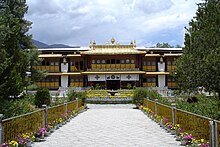Norbulingka
| Norbulingka | |
|---|---|

Norbulingka
|
|
| Tibetan transcription(s) | |
| Tibetan | ནོར་བུ་གླིང་ཀ་ |
| Wylie transliteration | Nor-bu-gling-ka |
| Chinese transcription(s) | |
| Traditional | 羅布林卡 |
| Simplified | 罗布林卡 |
|
|
|
| Coordinates | 29°39′14″N 91°05′30″E / 29.65389°N 91.09167°E |
| Monastery information | |
| Location | Lhasa, Tibet, China |
| Founded by | 7th Dalai Lama |
| Founded | 1755, completed 1783 |
| Date renovated | 1954 - 1956 |
| Type | Tibetan Buddhist |
| Lineage | Dalai Lama |
| Head Lama | 14th Dalai Lama |
Norbulingka (Standard Tibetan: ནོར་བུ་གླིང་ཀ་; Wylie: Nor-bu-gling-ka; simplified Chinese: 罗布林卡; traditional Chinese: 羅布林卡; literally "The Jewelled Park") is a palace and surrounding park in Lhasa, Tibet, China, built from 1755. It served as the traditional summer residence of the successive Dalai Lamas from the 1780s up until the 14th Dalai Lama's exile in 1959. Part of the "Historic Ensemble of the Potala Palace", Norbulingka is recognized as a UNESCO World Heritage Site, and was added as an extension of this Historic Ensemble in 2001. It was built by the 7th Dalai Lama and served both as administrative centre and religious centre. It is a unique representation of Tibetan palace architecture.
Norbulingka Palace is situated in the west side of Lhasa, a short distance to the southwest of Potala Palace. Norbulingka covers an area of around 36 hectares (89 acres) and considered to be the largest man made garden in Tibet.
Norbulingka park is considered the premier park of all such horticultural parks in similar ethnic settings in Tibet. During the summer and autumn months, the parks in Tibet, including the Norbulinga, become hubs of entertainment with dancing, singing, music and festivities. The park is where the annual Sho Dun or 'Yoghurt Festival' is held.
The Norbulingka palace has been mostly identified with the 13th and the 14th Dalai Lamas who commissioned most of the structures seen here now. During the invasion of Tibet in 1950, a number of buildings were damaged, but were rebuilt beginning in 2003, when the Chinese government initiated renovation works here to restore some of the damaged structures, and also the greenery, the flower gardens and the lakes.
...
Wikipedia

